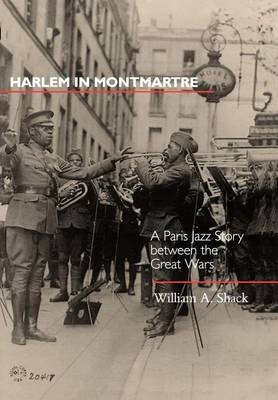
Harlem in Montmartre
A Paris Jazz Story between the Great Wars
Seiten
2001
University of California Press (Verlag)
978-0-520-22537-4 (ISBN)
University of California Press (Verlag)
978-0-520-22537-4 (ISBN)
- Lieferbar (Termin unbekannt)
- Versandkostenfrei innerhalb Deutschlands
- Auch auf Rechnung
- Verfügbarkeit in der Filiale vor Ort prüfen
- Artikel merken
During the years between the world wars, a small but dynamic community of African American jazz musicians left the US and settled in Paris. This book looks at this cultural moment, one in which African American musicians could flee the racism of the United States to pursue their lives and art in the relatively free context of bohemian Europe.
During the years between the world wars, a small but dynamic community of African American jazz musicians left the United States and settled in Paris, creating a vibrant expatriate musical scene and introducing jazz to the French. While the Harlem Renaissance was taking off across the Atlantic, entertainers in Montmartre, the epicenter of the Parisian scene, contributed enthusiastically to a culture that thrived for two decades, until the occupation of the city by German troops on June 18, 1940. In "Harlem in Montmartre", William Shack takes a fascinating look at this extraordinary cultural moment, one in which African American musicians could flee the racism of the United States to pursue their lives and art in the relatively free context of bohemian Europe.His book is the first comprehensive treatment of the rise and decline of the African American music community in Paris; in it, he considers the international dimensions of black experience in the modern era and explores the similarities and differences of Harlem-style jazz and culture in Europe and America.
Shack focuses on some of the principal actors who played critical roles in shaping the jazz scene in Montmartre - Josephine Baker, Sidney Bechet, and Bricktop - but he also discusses others who opened clubs, underwrote loans, and contributed their musical talents to this unparalleled experiment.As an anthropologist, Shack pays particular attention to the club culture. He describes the musicians' experiences, the settings in which they performed, and the response of French audiences. Shack's meticulous research and encyclopedic knowledge of Montmartre's jazz culture, including the people and places involved, make this a riveting, authoritative work. Seamlessly fusing biographical, sociological, and historical details, he brings this unique era to life and demonstrates how the Paris jazz scene played a crucial role in legitimizing jazz - both in Europe and the United States.
During the years between the world wars, a small but dynamic community of African American jazz musicians left the United States and settled in Paris, creating a vibrant expatriate musical scene and introducing jazz to the French. While the Harlem Renaissance was taking off across the Atlantic, entertainers in Montmartre, the epicenter of the Parisian scene, contributed enthusiastically to a culture that thrived for two decades, until the occupation of the city by German troops on June 18, 1940. In "Harlem in Montmartre", William Shack takes a fascinating look at this extraordinary cultural moment, one in which African American musicians could flee the racism of the United States to pursue their lives and art in the relatively free context of bohemian Europe.His book is the first comprehensive treatment of the rise and decline of the African American music community in Paris; in it, he considers the international dimensions of black experience in the modern era and explores the similarities and differences of Harlem-style jazz and culture in Europe and America.
Shack focuses on some of the principal actors who played critical roles in shaping the jazz scene in Montmartre - Josephine Baker, Sidney Bechet, and Bricktop - but he also discusses others who opened clubs, underwrote loans, and contributed their musical talents to this unparalleled experiment.As an anthropologist, Shack pays particular attention to the club culture. He describes the musicians' experiences, the settings in which they performed, and the response of French audiences. Shack's meticulous research and encyclopedic knowledge of Montmartre's jazz culture, including the people and places involved, make this a riveting, authoritative work. Seamlessly fusing biographical, sociological, and historical details, he brings this unique era to life and demonstrates how the Paris jazz scene played a crucial role in legitimizing jazz - both in Europe and the United States.
William A. Shack (1923--2000) was Professor of Anthropology at the University of California, Berkeley. Among his books are The Central Ethiopians: Amhara, Tigrina and Related Peoples (1975) and The Gurage: A People of the Ensete Culture (1966).
List of Illustrations Acknowledgments Introduction 1. Making Noise and Stomping Feet 2. Jazz from the Trenches 3. Le Jazz-Hot: The Roaring Twenties 4. Jim Crow: Sans Domicile Fixe 5. The Golden Age: The Thirties 6. Le Jazz-Cold: The Silent Forties 7. Final Notes: The Liberation of Jazz Coda Appendix: Zazou Chants Notes Bibliography Index
| Erscheint lt. Verlag | 4.9.2001 |
|---|---|
| Reihe/Serie | Music of the African Diaspora ; 4 |
| Zusatzinfo | 15 b-w photographs, 1 map |
| Verlagsort | Berkerley |
| Sprache | englisch |
| Maße | 152 x 229 mm |
| Gewicht | 499 g |
| Themenwelt | Kunst / Musik / Theater ► Musik ► Jazz / Blues |
| Geisteswissenschaften ► Geschichte | |
| Sozialwissenschaften | |
| ISBN-10 | 0-520-22537-6 / 0520225376 |
| ISBN-13 | 978-0-520-22537-4 / 9780520225374 |
| Zustand | Neuware |
| Haben Sie eine Frage zum Produkt? |
Mehr entdecken
aus dem Bereich
aus dem Bereich
zur politischen Ästhetik des Jazz
Buch | Hardcover (2023)
Phillip Reclam (Verlag)
38,00 €
Die Geschichte des Jazz in Deutschland
Buch | Softcover (2021)
Reclam, Philipp (Verlag)
20,00 €


